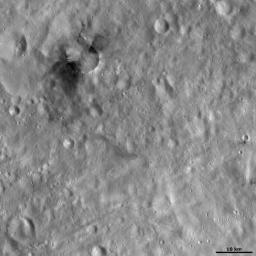
|
Occia Crater
- Click the image above for a larger view
- Full-Res JPEG (1024 x 1024) (148.7 kB)
- Full-Res TIFF (1024 x 1024) (1.1 MB)
Caption:
This Dawn framing camera (FC) image of Vesta shows Occia crater in the top left part of the image. This image is located slightly further to the south than the last image of the day, which showed Occia crater and its northern neighbor Rubria crater. The distinctive pattern of Occia's dark material is clear in this image: there are two main areas of dark material that are on either side of Occia, both inside and outside of the rim. This pattern is similar to the butterfly pattern of ejecta occasionally found on planets such as Mars. Butterfly patterns of ejecta consist of two separate lobes of ejecta on the opposite sides of a crater, which are formed when an impact crater was made by a very shallow impact onto a surface. However, from this image alone it is not clear if these areas of dark material formed in such a way.
This image is located in Vesta's Gegania quadrangle, in Vesta's southern hemisphere. NASA's Dawn spacecraft obtained this image with its framing camera on Oct. 28, 2011. This image was taken through the camera's clear filter. The distance to the surface of Vesta is 700 kilometers (435 miles) and the image has a resolution of about 68 meters (223 feet) per pixel. This image was acquired during the HAMO (high-altitude mapping orbit) phase of the mission.
Background Info:
The Dawn mission to Vesta and Ceres is managed by NASA's Jet Propulsion Laboratory, a division of the California Institute of Technology in Pasadena, for NASA's Science Mission Directorate, Washington D.C. UCLA is responsible for overall Dawn mission science. The Dawn framing cameras have been developed and built under the leadership of the Max Planck Institute for Solar System Research, Katlenburg-Lindau, Germany, with significant contributions by DLR German Aerospace Center, Institute of Planetary Research, Berlin, and in coordination with the Institute of Computer and Communication Network Engineering, Braunschweig. The Framing Camera project is funded by the Max Planck Society, DLR, and NASA/JPL.
More information about the Dawn mission is online at http://www.nasa.gov/dawn and http://dawn.jpl.nasa.gov .
Cataloging Keywords:
| Name | Value | Additional Values |
|---|---|---|
| Target | 4 Vesta | 1 Ceres |
| System | Main Belt | |
| Target Type | Asteroid | Dwarf Planet |
| Mission | Dawn | |
| Instrument Host | Dawn | |
| Host Type | Orbiter | |
| Instrument | Framing Camera (FC) | |
| Detector | ||
| Extra Keywords | Crater, Grayscale, Impact | |
| Acquisition Date | ||
| Release Date | 2012-05-10 | |
| Date in Caption | 2011-10-28 | |
| Image Credit | NASA/JPL-Caltech/UCLA/MPS/DLR/IDA | |
| Source | photojournal.jpl.nasa.gov/catalog/PIA15648 | |
| Identifier | PIA15648 | |
